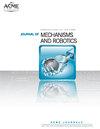基于cga的6-4 Stewart平台正位移分析几何建模方法
IF 3.2
4区 计算机科学
Q2 ENGINEERING, MECHANICAL
Journal of Mechanisms and Robotics-Transactions of the Asme
Pub Date : 2023-10-20
DOI:10.1115/1.4063501
引用次数: 0
摘要
提出了一种基于共形几何代数(CGA)的6-4 Stewart平台直接位移分析几何建模方法。首先,给出了四线与平面相交于一点的几何约束关系。其次,通过CGA运算推导出6-4 Stewart平台的新的坐标不变几何约束方程;第三,利用CGA理论建立了5个多项式方程。第四,在上述六个方程的基础上,采用Sylvester’s Dialytic消去法和Gröbner碱基法,在逐级倒序的字典顺序下,得到一个5 × 5的Sylvester’s矩阵。最后给出了运动平台上四个点的坐标。最后,通过数值算例验证了该方法的有效性。本研究的新颖之处在于在CGA框架下,提出了一种基于四线与平面相交于一点的几何约束关系的整体几何建模方法,具有良好的直观性,为求解其他复杂机构提供了新的思路。同时,该方法构造的Sylvester矩阵是目前已知文献中用于6-4 Stewart平台前向位移分析的最小矩阵。本文章由计算机程序翻译,如有差异,请以英文原文为准。
CGA-based geometric modeling method for forward displacement analysis of 6-4 Stewart platforms
Abstract This paper presents a novel geometric modeling method for direct displacement analysis of 6-4 Stewart platforms based on conformal geometric algebra (CGA). First, a geometric constraint relationship of four lines and a plane intersecting at a point is published. Second, a new coordinate-invariant geometric constraint equation of 6-4 Stewart platforms is deduced by CGA operation. Third, five polynomial equations are established by CGA theory. Fourth, based on the above six equations, a 5 × 5 Sylvester’s matrix is formulated by using Sylvester’s Dialytic elimination method and Gröbner bases method under the graded reverse lexicographical order. Finally, the coordinates of four points on the moving platform are revealed. Besides, a numerical example is used to prove the validity of the proposed method. The novelty of this study is that a whole geometric modeling method by geometric constraint relationship of four lines and a plane intersecting at a point is put forward under the CGA framework, which has good intuition and offers a novel idea for solving the other complex mechanisms. At the same time, Sylvester’s matrix constructed by this method is the smallest one in the known literature for forward displacement analysis of 6-4 Stewart platforms.
求助全文
通过发布文献求助,成功后即可免费获取论文全文。
去求助
来源期刊

Journal of Mechanisms and Robotics-Transactions of the Asme
ENGINEERING, MECHANICAL-ROBOTICS
CiteScore
5.60
自引率
15.40%
发文量
131
审稿时长
4.5 months
期刊介绍:
Fundamental theory, algorithms, design, manufacture, and experimental validation for mechanisms and robots; Theoretical and applied kinematics; Mechanism synthesis and design; Analysis and design of robot manipulators, hands and legs, soft robotics, compliant mechanisms, origami and folded robots, printed robots, and haptic devices; Novel fabrication; Actuation and control techniques for mechanisms and robotics; Bio-inspired approaches to mechanism and robot design; Mechanics and design of micro- and nano-scale devices.
 求助内容:
求助内容: 应助结果提醒方式:
应助结果提醒方式:


